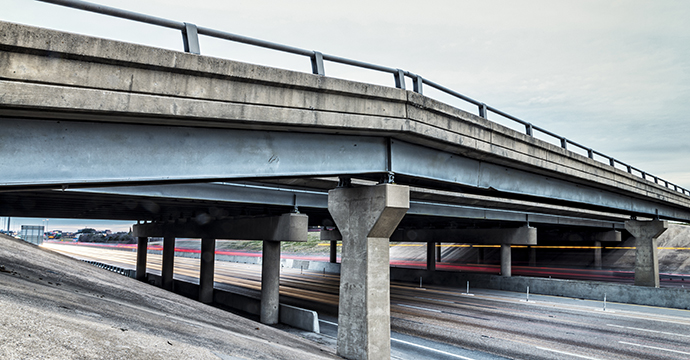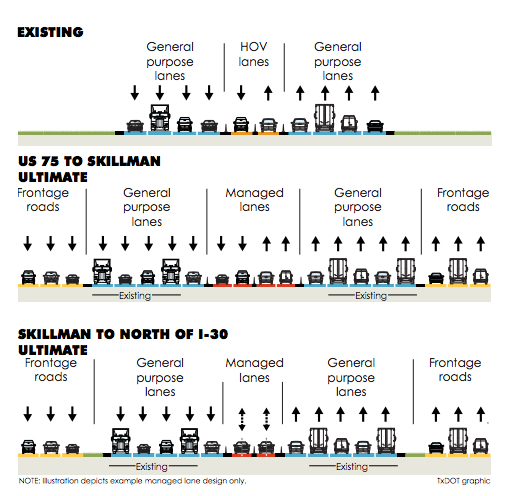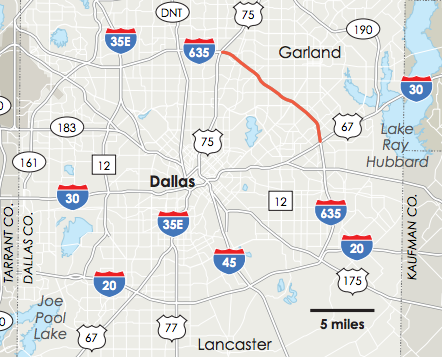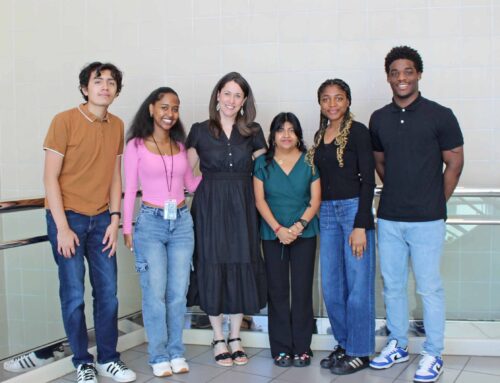I-635 East could be improved without the use of toll lanes, but a toll-less project would take many more years and cost a lot more money — even lawmakers who oppose managed roads will tell you this …
Earlier this month I shared a request from the Lake Highlands Area Improvement Association and the Lake Highlands Public Improvement District to call your state representative and pressure them to get the I-635 East project done, even if that means installing a toll lane.
Upon sharing that, the comments section reared its angry head, accusing me of mindlessly shilling for the private companies who own the toll ways. Yes, the comments section can be cruel, but also motivating. Good questions come up. Ultimately, we went and learned more about the whole thing — for example, why, exactly, are community leaders and city planners insisting upon a managed lane component?
We talked to the state representative who wrote the bill aimed at keeping toll lanes out of the I-635 East project; even she talked about the cons and drawbacks of a no-toll I-635 East (namely the longer and more expensive construction).
This is a complex issue, and we should learn as much as we can before deciding whether or not to support a toll component on I-635 East. It’s a lot to think about. Or we could just avoid thinking altogether and have a knee-jerk reaction like so many have and will.
Look, I hate tollways as much as the next guy, but in some cases an optional toll lane arguably makes sense. We have done much reporting on the tricky I-635 East and Skillman-I-635 and surrounding area situation and how it impacts Lake Highlands’ future at large. The most recent example appears in the April magazine, but I will also post it here. Basically, it should give you enough information to make an informed decision about whether or not having a toll lane is worth it. Then you can hash things out in the comments section.
This is the third installment of a three-part series about the future of Lake Highlands as it relates to the troubled Skillman-635 area. Read the Part 1 and Part 2.
A growing number of Dallas residents consider it the dirtiest of four-letter words: toll (especially when attached to road, way or even lane). And lawmakers have made it tougher for tolled roads to receive federal funding.
But some transportation experts, city planning professionals and local leaders say that optional “managed lanes” are essential to getting the I-635 LBJ East Project, from Central to I-30, underway.
All of this matters to Lake Highlands, because a recent land-use study shows the revitalization of one of our most downtrodden sections, the one that surrounds 635-Skillman, relies heavily on improvements to I-635 East — this has created a sense of urgency to see project funding approved during the current State Legislative Session.
The backlash against toll roads and lanes recently caused lawmakers to restrict some transportation dollars to non-tolled projects only.
While the move seemed to be what most taxpayers wanted, it hurts the Texas Department of Transportation (TxDOT)’s plan to fund part of the I-635 East project with managed lanes. TxDOT’s proposed tolled lanes, which would be operated by a private company, would abut free general-purpose lanes and new frontage roads. The project also calls for changes to I-635 that would protect neighboring areas from traffic noise.
At this juncture, Texas lawmakers are asking to see a similar plan that does not include tolled lanes.
Texas State Representative Cindy Burkett last week filed a bill calling for improvements and expansion of I-635 East without the use of tolled lanes. That means she is asking TxDOT to come up with alternatives to their existing plan, she explains. “How will they do it? That is something for their engineers to figure out,” she says, “and something that will be explored in the weeks ahead.”
The main objective in filing the bill, before the March 2015 filing deadline, she says, “was to keep the I-635 East project alive.” She says she has been working on it for about two years.
She prefers not to use tolls to fund roads, she says, “but with the current backlog of projects in Dallas County all vying for the same available dollars, all funding options need to be considered and discussed thoroughly, especially in highly congested areas like I-635 East.”
In fact, she says, there are many factors to consider, and she would be open to amendments to her bill that would allow tolled lanes.
“The fact is that there is a lack of funding.” She explains that while funds for transportation projects are available, the sum of funds for all the proposed projects around Dallas County are not nearly enough to cover the $2.4 billion that TxDOT estimates is needed just for the I-635 East project.
The clear alternative to adding tolled lanes is to accept a longer and more expensive construction period, Burkett says, and it is likely that representatives and their constituents will need to decide between a toll component and a longer, more expensive project.
“With available funding, they can begin completing the project in smaller sections,” she says.
That could mean taking more than 10 years to complete the full project. And because of the extended amount of time, it also means an increase in the overall cost of the road by an estimated 30 percent, Burkett says.
She understands, however, that people are concerned about debt and about toll companies taking over Texas roadways.
“Some people say they are OK with a toll lane, they say, ‘yes, put it in, get this road done.’ Some say, ‘yes, I am happy to pay to avoid traffic when I need to get somewhere.’ And others feel like if we allow another toll lane we are giving in.”
She says she is sensitive to both sides.
The Legislature will decide by vote whether amendments allowing a toll component will pass, Burkett says, so every taxpayer should let his or her district representative know what they want.
“I know I want to know what my constituents think,” she says. “I am listening to every call.”
Many in Lake Highlands say I-635 East improvements need to get going, without further delay, and if that means a toll component, OK. Those who advocate a managed lane component for I-635 say it is the most straightforward and efficient way to get the project underway.
“Unfortunately there really isn’t another tool to pay for major highway projects right now,” says Kathy Stewart, executive director of the Lake Highlands Public Improvement District.
“The quality of life, safety and convenience of Lake Highlands residents will be impacted by I-635 East road improvements,” adds Murray Morgan, president of the Lake Highlands Area Improvement Association, and if that means adding a managed lane component, so be it, he says.
“People are telling their representatives they don’t want the tolled lanes,” Morgan says, “but the thing is, they are necessary to getting this thing done. The plans are good, but this needs a push and that push needs to come from the residents.”
In the February Lake Highlands Advocate, in part one of this series on the future of Lake Highlands, we looked at how a specific component of the I-635 East project, the 635-Skillman interchange realignment, would impact development around 635-Skillman.
According to a joint land-use study by the North Texas Central Council of Governments and the City of Dallas, the Skillman-635 transportation problems not only cause traffic accidents and snarls, but also could be limiting our area’s potential for economic growth. The thoroughfare situation makes inefficient use of adjacent land, repels quality developers, and ultimately perpetuates proliferation of undesirable businesses and properties. The I-635 East Project ties directly into area improvements, according to the study.








